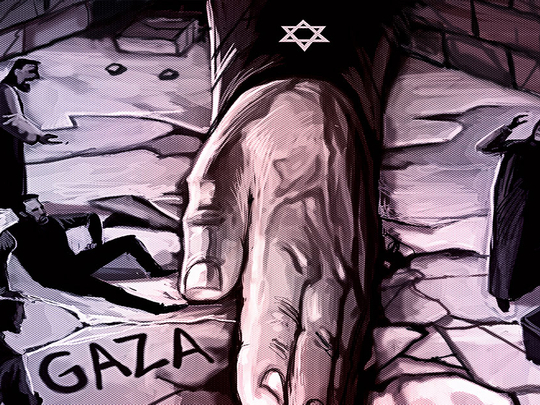
Again, the Gaza Strip stands alone in the face of the Israeli blockade, a policy that deals with the area as a group of people running a terrorist movement (Hamas). Israel continues its military pressure while ignoring the deteriorating socioeconomic situation in the Strip, which caused concern among various leaders of the Israeli security institutions. Quoted by Israeli daily Haaretz, they warned of “economic collapse if the policy of closures and blockade continued along with lack of facilities or supply of electricity and all the other necessities of life and living services”. They added: “The economy of the Gaza Strip is in a state of complete collapse, such as zero to minus, along with the state of civilian infrastructure.” Furthermore, they cautioned that “the situation will deteriorate, and it may reach to thousands of attempts to cross the fence separating Israel, a scenario that cannot be overcome without reaching escalation.” Similarly, the Los Angeles Times reported: “Hamas and Israel do not want another war in Gaza, but that is not enough to prevent it from erupting,” warning of “possible protests involving thousands of unarmed civilians on the border”. They may try to drop or uproot the fence separating them, which may lead to two things: The use of the (Israeli) military violent force with civilians, or the influx of thousands of Gaza residents to southern Israel.
The ‘catastrophe’ in the Gaza Strip is similar to the case of ‘clinical death’ economically, socially, structurally and in the infrastructure, and things are at risk of uncontrollable explosion. Unemployment is on the rise, social problems are worsening, factories are stopping, the financial situation is deteriorating and several other vital things are getting worse day by day. With all this deterioration, United States President Donald Trump’s decision to cut support for the United Nations Relief and Works Agency (UNRWA) has exacerbated the situation. The potential ‘catastrophe’ becomes clearer with the fact sheet on the local economic development in Gaza Strip issued by the International Commission to Support the Palestinian People’s Rights (ICSPR). This sheet indicated that the area “faces multiple challenges and problems hampering achievement of a real economic development”. According to the report: “80 per cent of Gaza population depends on international assistance. More than 70 per cent suffers from lack of healthy or safe food, while the number of those unemployed during the third quarter of 2017 reached 243,800 — amounting to 46.6 per cent.” Moreover, it was indicated that “60 per cent of the factories and workshops were forced to decrease work or shut down since the imposition of the blockade. The rate of investment to gross domestic product declined from 17.6 per cent before the blockade (in 2006-2008) to 2.1 per cent in 2015. 78 per cent of the employed people are paid employees, while only 13.9 per cent are self-employed. This indicates that most of the private business groups in Gaza are in poverty and rely on assistance”.
It is to be noted that the Egyptian Rafah border crossing was open for 21 days only in 2017! Moreover, according to the Gaza Health Ministry, three hospitals and 13 other medical centres have stopped due to fuel shortages. The UN Office for Coordination of Humanitarian Affairs (OCHA) said, “the United Nations is coordinating efforts supported by donor countries to provide emergency fuel supplies to operate back-up generators and vehicles to ensure minimum level of health services, water and solid waste collection in light of the acute electricity shortage that the blockaded Gaza Strip is facing”. There is a need for 1.4 million litres of fuel monthly, or $10 million (Dh36.78 million) annually, to keep all the vital facilities running.
The UN Envoy to the Middle East, Nicolai Miladinov, has warned of the dangers of continuing humanitarian and security conditions in Gaza Strip, criticising Israel’s intransigence on the blockade issue, which has also been addressed by some Israeli writers, politicians and security officials. “Infectious diseases will not stop at the Erez checkpoint,” says Israeli journalist Amos Harel. “There is no technology that can detect and destroy it before the wall is breached in Kerem Abu Salem Crossing, where it also affects Israeli citizens. The question is: Will Hamas return to using weapons against Israel?” Israel is bound to face more pressing challenges. How will the spread of diseases to Naqab be prevented? What will they do when the hospitals collapse in Gaza or when the water network is unable to work? What would they do if a large group of Palestinians stopped at the gates of Israel in the wall and begged Israel to save them during a humanitarian crisis of a magnitude we have not yet faced!”
The Israeli President, Reuven Rivlin, has warned of the possibility of a humanitarian crisis in Gaza Strip soon, but he also attacked Hamas, accusing it of preventing any improvement in the situation in the area. “The hour will come when the infrastructure in Gaza will collapse and many citizens will be left in trouble, without sanitation facilities, exposed to the pollution of underground water and epidemics,” he said.
Indeed, after 11 years of total Israeli siege, a full-fledged war crime, it is clear that Gaza’s demographic, economic, political and social structure has become a volcano ready for eruption.
Professor As’ad Abdul Rahman is the chairman of the Palestinian Encyclopaedia.








